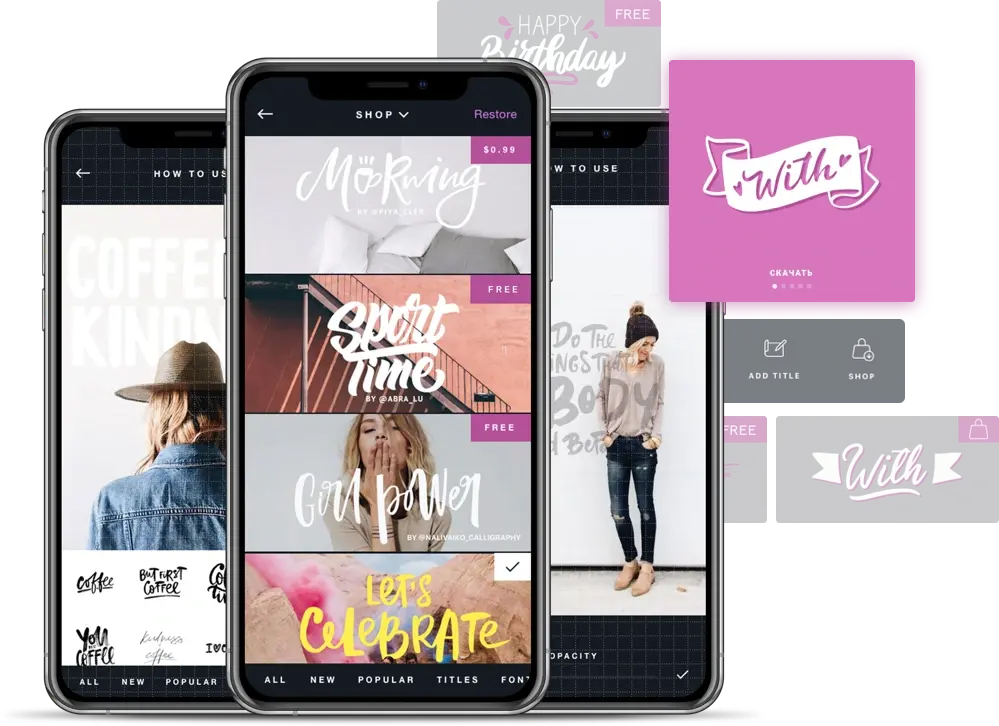PWA vs Native: Is the Choice Really Easy?
Today, over 10 billion mobile devices are regularly used by people globally for communication, entertainment, shopping, etc. Along with the global popularity of smartphones, competition among hardware/software providers in the market grows accordingly. User audiences from all around the world are downloading billions of both paid and freeware apps on an hourly, just take a look:
That’s what makes service providers, developers, and entrepreneurs seek new ways to impact their target users better than competitors in the niche. As such, new, optimized application formats appear. In particular, you may have heard that mobile software vendors increasingly shift focus toward PWA vs native solutions. Why is it becoming more and more difficult for companies to make the final choice between the two? Let’s find out.
PWA vs Native Apps: An Outline of Comparison
Back in the day, native software was the only way to go. Developers used to take a target platform and set of devices to create a specific, narrowly-optimized solution, which was a native app in a nutshell. In those blessed times, there was no such thing as the choice between progressive web apps vs native solutions and, usually, the only dilemma one could face was “Android or iOS?”.
Things changed with the introduction of tons of new hardware models and a bunch of new OS’s - all with their own specifics and nuances. It has simply become too difficult to satisfy the needs of all users in all existing niches. On top of that, eager entrepreneurs started invading global markets, looking for affordable ways to build dedicated mobile apps.
The format of PWA appeared as a great cost-efficient, universal alternative to native solutions. Progressive Web Apps work from a browser, which spawns tons of advantages:
- For users - there’s no need to download anything, no need to get a powerful smartphone to match the specs, just make sure you’re connected to the Wi-Fi and you’re good to go.
- For software providers - no need to upload the solution to any of the app stores or spend budget on the thorough optimization for different devices/OS’s. However, this great innovation.
Discover the secrets to creating an AI-powered trip planning app
One great BUT, however, is that this seemingly game-changing innovation isn’t free from its own downsides. Thus, PWA solutions don’t work offline, limiting the capabilities of certain user niches. They also can’t access some of the native hardware features (like accelerometer) and can’t be distributed in app stores (which can be a significant disadvantage for some businesses).
To sacrifice the exclusiveness and commercial ambitions over wide accessibility and ease of use at a more affordable budget? Or to keep it narrowly optimized, niche-targeted, and highly functional with bigger investments? This is, basically, the web app vs native app choice most modern mobile app development companies and entrepreneurs have to figure out.

All in all, the percentage of progressive web apps vs native apps has been increasing steadily due to more independent entrepreneurs wishing to enter the market as fast as possible. A whole bunch of blue-chip companies, including Twitter, Instagram, and Facebook, have been adding PWAs on top of their native solutions as well to gain the widest user reach.
This still doesn’t mean, however, that this relatively new fancy type of apps is always the winning choice. It all depends on the scale of business or height of ambition, not mentioning many individual factors. Let’s have a deeper look.
Progressive Web Apps vs Native: The Significance of The Right Choice
Recently, a customer tasked our team with a request to build a single-page app for a garage owners/vehicle owners marketplace. We had the readymade design and specifications, as well as the back end and the endpoints. Our primary task was to develop the front end aspects for a web solution. Long story short, we had some negotiations and took up the job.
The unexpected thing was that neither the design wireframe nor the specifications fit the web specifics - they were meant for a native mobile app, which was not the type of product our developers had been preparing for. At that time, the original designer wasn’t available anymore and there was no time for revamping the screens.
On top of that, the client didn’t really have the budget to build native iOS and Android versions of the app. Eventually, the solution we offered as the best take on the whole situation was to opt for a PWA built via Service Worker.
AppForType Mobile App

This allowed us to make the final solution available for all existing platforms and enable push notifications and camera availability, just like in native apps.
This case underscored the supremacy of PWAs in many aspects based on real-world practice. But there’s more.
The Advantages of Progressive Web App vs Native
Talking about PWA vs native app, PWAs top native apps in the following aspects:
1. Development costs
Developing an app as a whole is quite a pricey venture, with the total cost amounting to several thousand USD depending on the scale and features.
Common app development prices may vary depending on many factors, one of the pivotal ones being the location of the team whose services you are going to employ. Typically, developers from Eastern Europe charge less while providing high-quality value. So your rule of thumb while searching for an outsourcer should be looking for one hailing from those countries.
Keep in mind, however, that building a native app will certainly cost you more. All because you’ll need to create a separate app version for each operating system, which is done in different programming languages. Alternatively, building a PWA doesn’t require creating several versions since it is a case of “one size fits all platforms”.
An even more cost-effective solution still is to turn your existing website into a progressive app, which our company excels at.
2. Download and installation
Forrester research firm held a survey to find out the average number of apps a smartphone owner installs. The researchers were absolutely gobsmacked to discover that this number was zero. People simply don’t wish to bother with the lengthy process of installation that ends in the app being used only a couple of times and eventually deleted. Constant updates are also annoying or simply ignored (in this case, an app becomes obsolete after the first missed update).
However, it is only native apps that cause this amount of headache, since PWAs don’t need to be installed at all. Their web nature allows users to simply add the app to the home screen in a couple of taps, after which it is ready to go. The updates happen on the backend side of things, not bothering regular users in any way.
3. Performance agility
PWAs load faster. All due to service workers who handle offline requests, cache resources, and harmonize data with a remote server, which translates into a speedy operation of your PWA. Even at low Internet connection speeds. In turn, native apps’ performance mostly depends on the optimization effort and smartphone characteristics.
4. Publishability
Native apps must be published on App Store or Play Store (depending on the platform) to be accessed by users. Both stores have certain preliminary requirements your app will have to comply with, and the App Store has a registration charge.
In case you deal with all the policies and agree to pay for your “position on the market”, the stores will take some time to finally issue the permission for publishing, which has to be renewed each time you decide to update your app. Sounds bothersome? Then opt for PWA. Being websites in nature, they are made available to a wide audience on a simple condition of using browser and URL correctly.
On the other hand, despite the fact that PWAs do better in terms of wide distribution, web stores' complicated publishing procedures guarantee that only high-quality apps eventually reach users. So being accepted for publishing is a hallmark of the top className your app now belongs to, which inevitably translates into a sales boost.
5. SEO-friendliness
If you wish your app to be easily discovered by people online, you shouldn’t limit your reach to an app store or two. Search engines don’t list the contents of such stores. But PWAs can efficiently be discovered by potential users that google for they need exactly.
It is true that you can always employ ASO (which stands for App Store Optimization). By thorough meta and title description phrasing, keyword research, adequate screenshots, and appropriate categorization, you can make your native app more SEO-friendly.
But again, it takes a lot of money, time, and effort – are you ready to go through all this? And even if you are, the awareness that after implementing all these measures your native app will never beat PWA in discoverability will haunt you.
Partner with us to develop a tailored software solution
The Advantages of Native App vs PWA
The domination of PWAs is not absolute, since our experts have discovered two aspects where they can’t surpass native apps.
1. The scope of features
Native apps offer tons of insightful capabilities (geofencing, smart lock, proximity sensor, etc.) that are not available in PWAs. Moreover, they can work along with other native apps to, for instance, make calls or log in and check out fast.
Thus, they outperform PWAs, which provide a much more limited range of functions. What is more unpleasant is the erratic character of the functions they do maintain. There is an uncomfortable difference in the API’s support of service workers from platform to platform. As a result, some PWAs enable push notifications or mobile payments while others don’t.
2. Security
Being more resistant to hacker attacks than regular sites, PWAs still can’t rival native apps in the number of additional security measures, such as multi-aspect authentication or certificate pinning. So, when dealing with native apps, customers can be more confident that their personal and financial data aren’t mishandled.
Comparing the App Types: A Concise Summary
If you still rack your brains weighing up PWA vs native app and how to choose between them, here is a summary of this now-classNameic opposition in the form of the comprehensive FAQ.
What is the difference between PWA and a Native app?
The latter are special software installed on your gadget that allows engaging in eCommerce, gaming, banking, or other IT activities. The former are a kind of websites that do pretty much the same with certain limitations and no need for installation.
Why are Progressive Web Apps better than Native?
PWAs shouldn’t be optimized for a particular device or run on a particular platform (typically iOS or Android). They are compatible with any gadget with any screen size, they don’t require installation, and, moreover, they are fast in operation, small in weight, remarkably SEO-friendly, and considerably cheaper to build.
Will PWAs replace Native apps? Or, in other words, is PWA the future?
Despite the fact that many companies are starting to migrate into the PWA realm, our expert developers are far from being sure that native apps are doomed. They manifest a significant edge over PWAs in quality, security, and the number of features, being reliable and credible solutions that provide a comfortable user experience.
If you are still in doubt as to which app to opt for, or want to obtain a top-notch app of any kind, our team is at your disposal to provide any consultation or create any software you may need.

Our team is dedicated to delivering high-quality services and achieving results that exceed clients' expectations. Let’s discuss how we can help your business succeed.


SHARE: